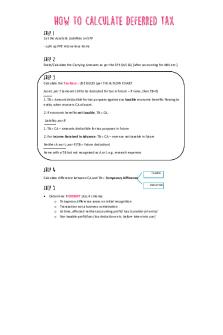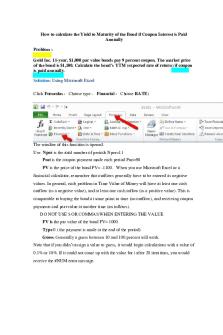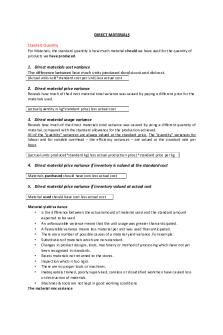Altman Z-Score How To Calculate A Z-Score PDF

| Title | Altman Z-Score How To Calculate A Z-Score |
|---|---|
| Author | cob Doe |
| Course | Fixed-Income Securities |
| Institution | Binghamton University |
| Pages | 4 |
| File Size | 175.8 KB |
| File Type | |
| Total Downloads | 116 |
| Total Views | 169 |
Summary
Download Altman Z-Score How To Calculate A Z-Score PDF
Description
How To Calculate A Z-Score by Ben McClure
How do you know when a company is at risk of corporate collapse? To detect any signs of looming bankruptcy, investors calculate and analyze all kinds of financial ratios: working capital, profitability, debt levels and liquidity. The trouble is, each ratio is unique and tells a different story about a firm's financial health. At times they can even appear to contradict each other. Having to rely on a bunch of individual ratios, the investor may find it confusing and difficult to know when a stock is going to the wall. (For background reading, check out An Overview Of Corporate Bankruptcy.)
Tutorial: Financial Ratios In a bid to resolve this conundrum, NYU Professor Edward Altman introduced the Z-score formula in the late 1960s. Rather than search for a single best ratio, Altman built a model that distills five key performance ratios into a single score. As it turns out, the Z-score gives investors a pretty good snapshot of corporate financial health. Here we look at how to calculate the Z-score and how investors can use it to help make buy and sell decisions.
The Z-score Formula
Here is the formula (for manufacturing firms), which is built out of the five weighted financial ratios:
Z-Score = 1.2A + 1.4B + 3.3C + 0.6D + 1.0E Where: A = Working Capital/Total Assets B = Retained Earnings/Total Assets C = Earnings Before Interest & Tax/Total Assets D = Market Value of Equity/Total Liabilities E = Sales/Total Assets Strictly speaking, the lower the score, the higher the odds are that a company is headed for bankruptcy. A Z-score of lower than 1.8, in particular, indicates that the company is heading for bankruptcy. Companies with scores above 3 are unlikely to enter bankruptcy. Scores in between 1.8
1
and 3 lie in a gray area.
Breaking Down the Z Now that we know the formula, it's helpful to examine why these particular ratios are included. Let's take a look at the significance of each one:
Working Capital/Total Assets (WC/TA) This ratio is a good test for corporate distress. A firm with negative working capital is likely to experience problems meeting its short-term obligations because there simply is not enough current assets to cover those obligations. By contrast, a firm with significantly positive working capital rarely has trouble paying its bills. (For background reading, see Working Capital Works.)
Retained Earnings/Total Assets (RE/TA) This ratio measures the amount of reinvested earnings or losses, which reflects the extent of the company's leverage. Companies with low RE/TA are financing capital expenditure through borrowings rather than through retained earnings. Companies with high RE/TA suggest a history of profitability and the ability to stand up to a bad year of losses.
Earnings Before Interest and Tax/Total Assets (EBIT/TA ) This is a version of return on assets (ROA), an effective way of assessing a firm's ability to squeeze profits from its assets before factors like interest and tax are deducted.
Market Value of Equity/Total Liabilities (ME/TL) This is a ratio that shows - if a firm were to become insolvent - how much the company's market value would decline before liabilities exceed assets on the financial statements. This ratio adds a market value dimension to the model that isn't based on pure fundamentals. In other words, a durable market capitalization can be interpreted as the market's confidence in the company's solid financial position.
Sales/Total Assets (S/TA) This tells investors how well management handles competition and how efficiently the firm uses assets to generate sales. Failure to grow market share translates into a low or falling S/TA.
WorldCom Test To demonstrate the power of the Z-score, let's look at how it holds up with a tricky test case. Consider the infamous collapse of telecommunications giant WorldCom in 2002. WorldCom's
2
bankruptcy created $100 billion in losses for its investors after management falsely recorded billions of dollars as capital expenditures rather than operating costs.
Here we calculate Z-scores for WorldCom using annual 10-K financial reports for years ending
December 31, 1999, 2000 and 2001. Indeed, WorldCom's Z-score suffered a sharp fall. Also note that the Z-score moved from the gray area into the danger zone in 2000 and 2001, before declaring bankruptcy in 2002. Input X1 X2 X3 X4 X5
Financial Ratio Working Capital/ Total Assets Retained Earnings/Total Assets EBIT/Total Assets Market Value/Total Liabilities Sales/Total Assets
Z-score
1999
2000
2001
-0.09
-0.08
0
-0.02
0.03
0.04
.09
.08
.02
3.7
1.2
.50
0.51
0.42
0.3
2.5
1.4
.85
But WorldCom management cooked the books, inflating the company's earnings and assets in the financial statements. What impact do these shenanigans have on the Z-score? Overstated earnings likely increase the EBIT/total assets ratio in the Z-score model, but overstated assets would actually shrink three of the other ratios with total assets in the denominator. So the overall impact of the false accounting on the company's Z-score is likely to be downward. (For more on corporate accounting gone wrong, see Cooking The Books 101.) Where Z-Score Falls Short Alas, the Z-score is not perfect and needs to be calculated and interpreted with care. For starters, the Z-score is not immune to false accounting practices. As WorldCom demonstrates, companies in trouble may be tempted to misrepresent financials. The Z-score is only as accurate as the data that goes into it.
The Z-score also isn't much use for new companies with little or no earnings. These companies, regardless of their financial health, will score low. Moreover, the Z-score doesn't address the issue of cash flows directly, only hinting at it through the use of the net working capital-to-asset ratio. After all,
3
it takes cash to pay the bills. Finally, Z-scores can swing from quarter to quarter when a company records one-time write-offs. These can change the final score, suggesting that a company that's really not at risk is on the brink of bankruptcy. Conclusion To keep an eye on their investments, investors should consider checking their companies' Z-score on a regular basis. A deteriorating Z-score can signal trouble ahead and provide a simpler conclusion than the mass of ratios. Given its shortcomings, the Z-score is probably better used as a gauge of relative financial health rather than as a predictor. Arguably, it's best to use the model as a quick check of financial health, but if the score indicates a problem, it's a good idea to conduct a more detailed analysis.
by Ben McClure Ben McClure is a long-time contributor to Investopedia.com. Ben is the director of Bay of Thermi Limited, an independent research and consulting firm that specializes in preparing early stage ventures for new investment and the marketplace. He works with a wide range of clients in the North America, Europe and Latin America. Ben was a highly-rated European equities analyst at London-based Old Mutual Securities, and led new venture development at a major technology commercialization consulting group in Canada. He started his career as writer/analyst at the Economist Group. Mr. McClure graduated from the University of Alberta's School of Business with an MBA. Ben's hard and fast investing philosophy is that the herd is always wrong, but heck, if it pays, there's nothing wrong with being a sheep. He lives in Thessaloniki, Greece. You can learn more about Bay of Thermi Limited at www.bayofthermi.com.
4...
Similar Free PDFs

How to Calculate Beta
- 2 Pages

How to Calculate GST in a Flash
- 2 Pages

How to Calculate Deferred Tax
- 3 Pages

How to Calculate your GPA
- 1 Pages

How to write a Comment
- 1 Pages
Popular Institutions
- Tinajero National High School - Annex
- Politeknik Caltex Riau
- Yokohama City University
- SGT University
- University of Al-Qadisiyah
- Divine Word College of Vigan
- Techniek College Rotterdam
- Universidade de Santiago
- Universiti Teknologi MARA Cawangan Johor Kampus Pasir Gudang
- Poltekkes Kemenkes Yogyakarta
- Baguio City National High School
- Colegio san marcos
- preparatoria uno
- Centro de Bachillerato Tecnológico Industrial y de Servicios No. 107
- Dalian Maritime University
- Quang Trung Secondary School
- Colegio Tecnológico en Informática
- Corporación Regional de Educación Superior
- Grupo CEDVA
- Dar Al Uloom University
- Centro de Estudios Preuniversitarios de la Universidad Nacional de Ingeniería
- 上智大学
- Aakash International School, Nuna Majara
- San Felipe Neri Catholic School
- Kang Chiao International School - New Taipei City
- Misamis Occidental National High School
- Institución Educativa Escuela Normal Juan Ladrilleros
- Kolehiyo ng Pantukan
- Batanes State College
- Instituto Continental
- Sekolah Menengah Kejuruan Kesehatan Kaltara (Tarakan)
- Colegio de La Inmaculada Concepcion - Cebu










